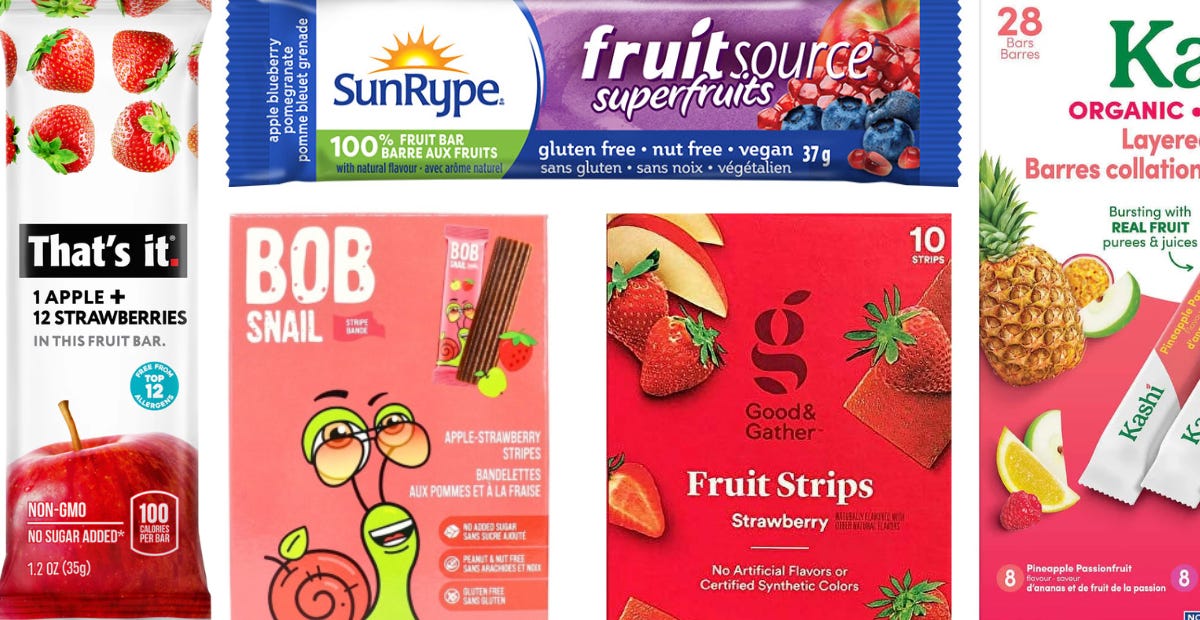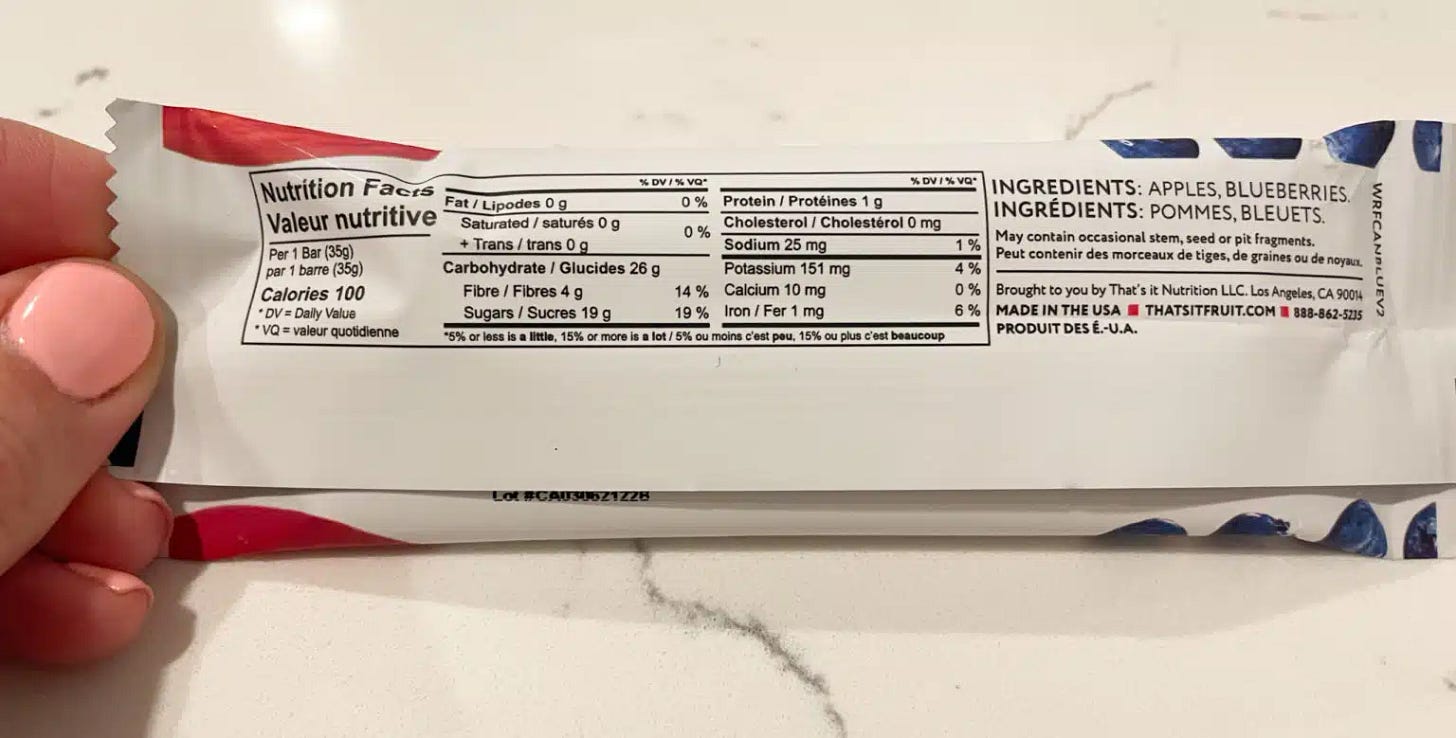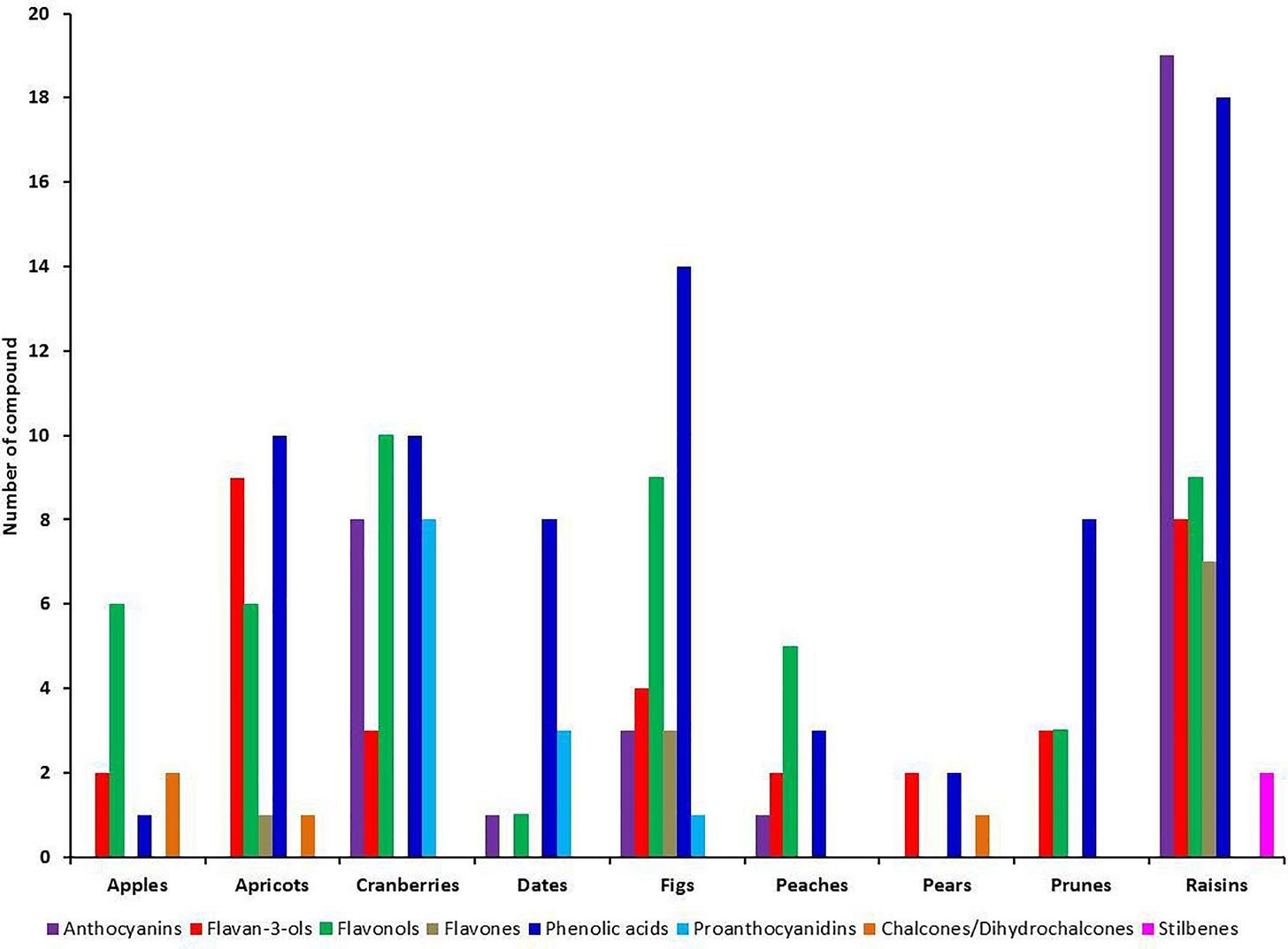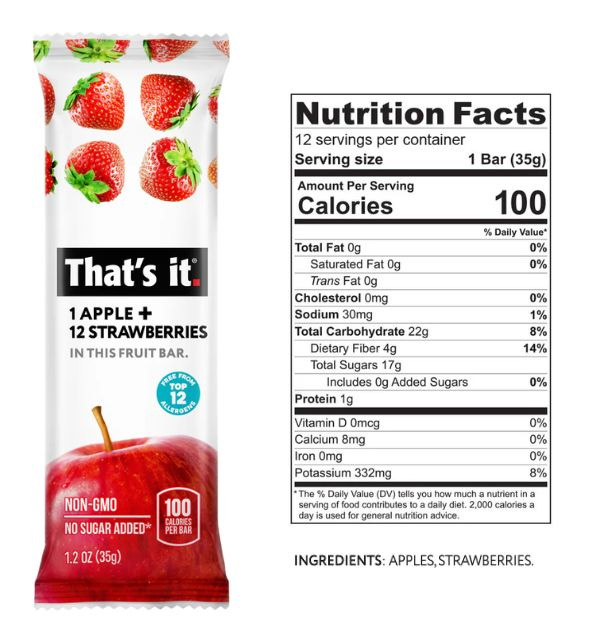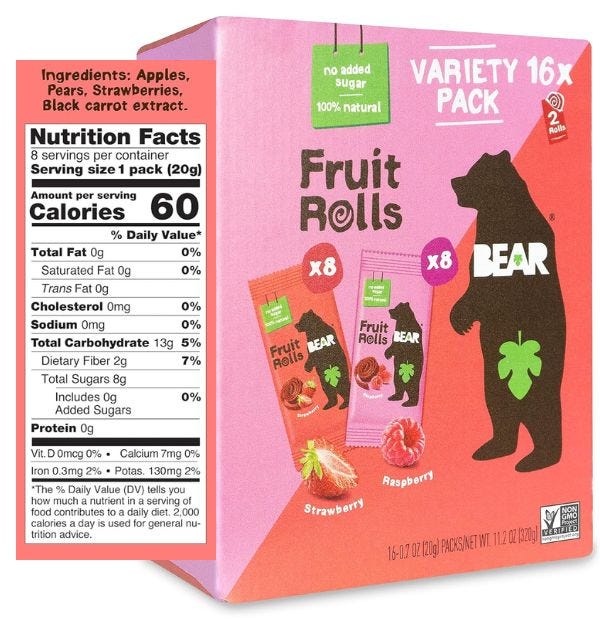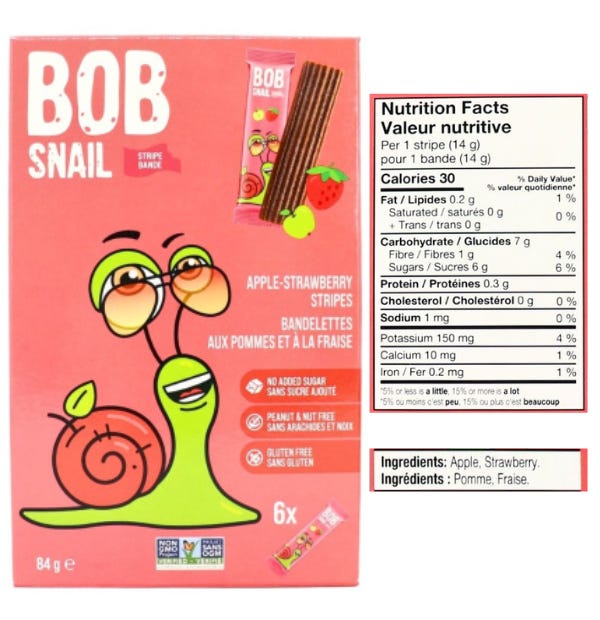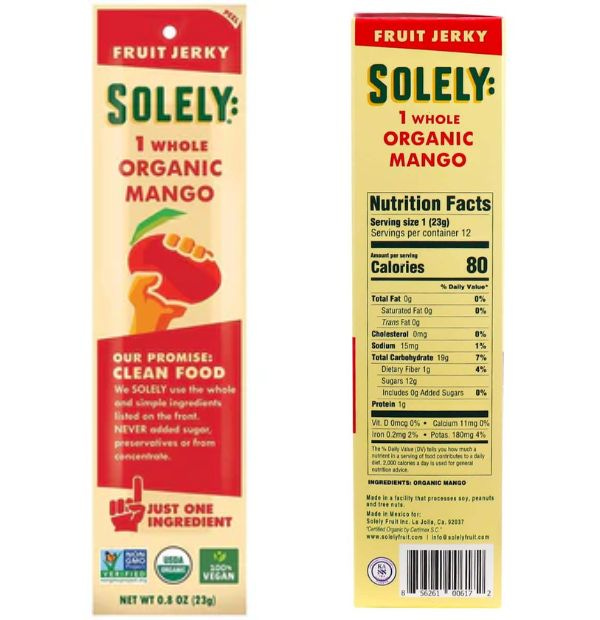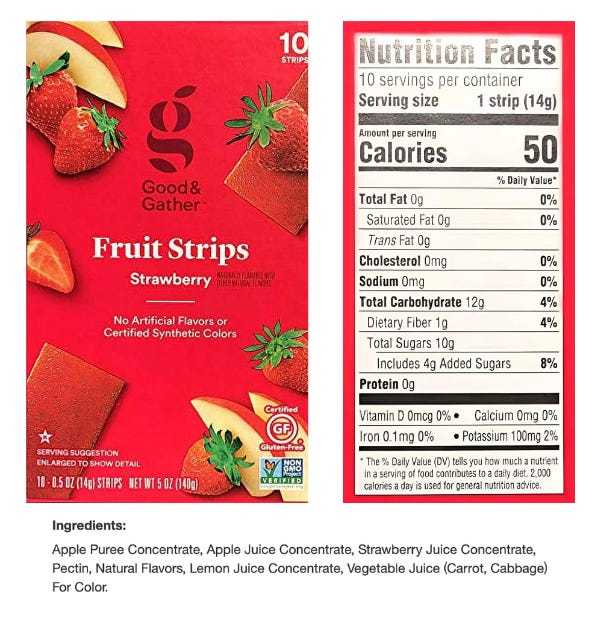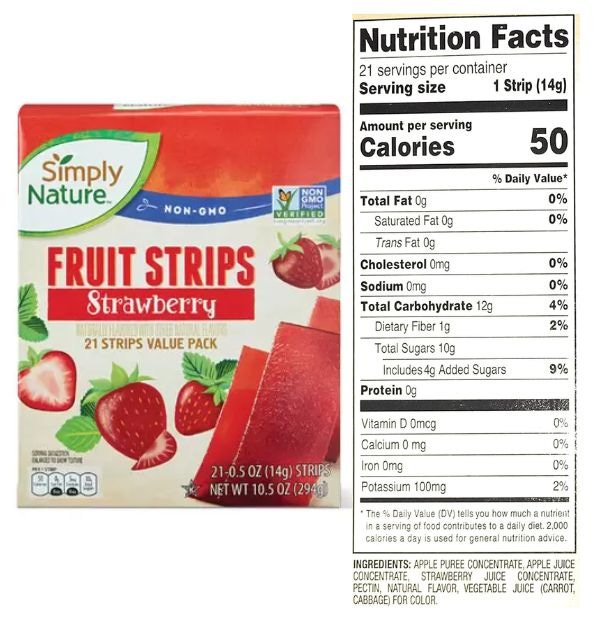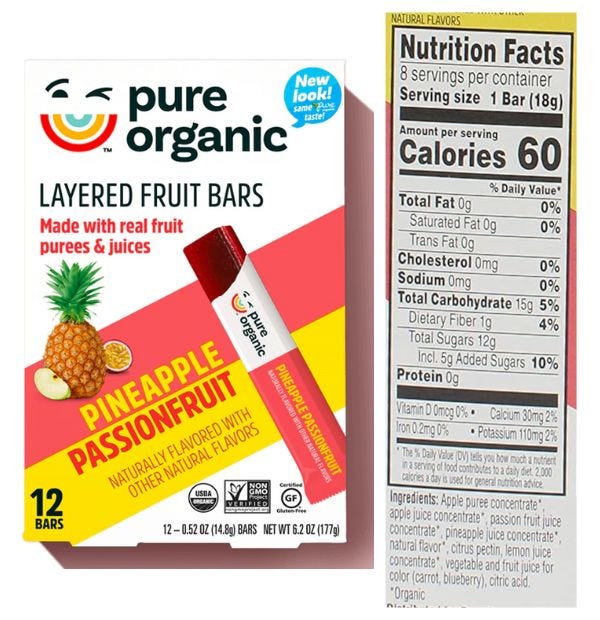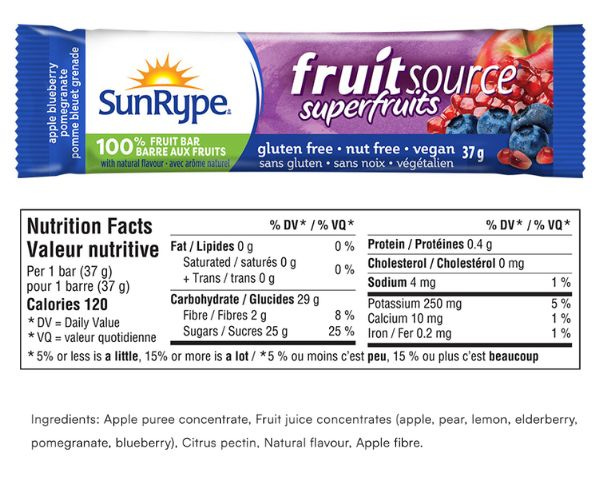Hello readers! The number of available dried fruit snacks has increased significantly in recent years as consumers demand more “natural” packaged snacks. And on a scale of fresh produce to Cheetos, fruit bars seem as natural as it gets for a shelf-stable food. But are these products actually nutritious, or just concentrated sources of sugar?
This week I’m looking beyond the nutrition facts table to share what we know about the micronutrient and antioxidant content of dried fruit products. I’ve also included a brief review of popular fruit bar brands to help you make an informed decision at the grocery store.
Note: if part of this post gets cut off in your inbox (due to length), click the ‘READ IN APP’ button at the top of this page for the full version.
If you haven’t already done so, hit the Subscribe button below so you don’t miss any future editions of The Grocery Edit!
Sugar Content of Fruit Bars Vs. Fresh Fruit
Fresh fruit is made up of mostly water. Depending on the type, fresh fruit contains at least 70% water, with many varieties containing more than 85% water. When fresh fruit is dried to make fruit bars, this water volume is lost but the sugar content remains stable. Some fruit bars are also infused with fruit juice concentrate to improve the flavour of the product. These products contain added sugars and are considered higher in sugar compared to their fresh counterparts.
However, many dried fruit bar brands are free from added sugar. Compared to whole fruit, no-added-sugar fruit bars do not contain more sugar compared to an equal amount of fresh fruit, but the sugar is more concentrated because up to 85% of the volume of the original fresh fruit has been removed.
Is fruit juice considered an added sugar?
Yes! Even though fruit juice is technically a natural sugar, when used as an ingredient, it is considered an added sugar. Therefore, in the U.S and Canada, products cannot use a “no added sugar” claim if they contain fruit juice as an ingredient1.
Glycemic Index of Dried Fruit
Because the sugar in dried fruit is concentrated, it has been assumed that dried fruit would have a high glycemic index and cause more of a spike in blood sugar compared to fresh. However, many varieties of dried fruit actually have a low (<55) to medium (56-69) glycemic index, likely because the fibre content remains intact in dried fruit.
For example, raisins have an estimated glycemic index of 49-62, depending on the variety2. In comparison, whole grapes have a glycemic index of 42-62.
Other dried fruit products, such as dried apples, dried apricots, and banana chips are also considered low glycemic, including the Sunrise brand Strawberry & Wildberry fruit bar which has a reported glycemic index of 403.
Micronutrient Content of Fruit Bars
Fresh fruit contains various essential vitamins and minerals, but are these nutrients retained after the fruit is dried? As it turns out, dried fruit does retain some of its vitamins and minerals. However, the amount of micronutrients retained differs depending on the fruit and the type of drying process.
For example, when we compare a 1/2 cup of fresh blueberries with an equivalent amount of dried (adjusted for volume), dried blueberries retain approximately half of the original micronutrient content of fresh4. In another example, when a peach is dried, it loses most of its vitamin C but retains 68% magnesium and 93% of its potassium content5.
But why aren’t these additional micronutrients listed on food labels?
Since dried fruit is typically a source of various micronutrients, you may wonder why you don’t always see this reflected on fruit bar food labels. This is because most food labels will include only the minimum required nutrients (see example below). These are the nutrients that must be present on all food labels, but manufacturers can opt to add additional nutrients at their discretion. This means a food may contain additional nutrients, for example, vitamin C, and it’s not required to be on the Nutrition Facts table.
Antioxidant Content of Fruit Bars
Another important benefit of fruit can be attributed to its antioxidant content, but is any of this retained after the drying process? Yes! Dried fruit generally contains a variety of bioactive compounds such as polyphenols and flavonoids, meaning that even in dried form, fruit offers antioxidant benefits (see the chart below). But similar to micronutrient content, the actual amounts will vary depending on the fruit in question and the method of drying used.
Dried fruit and satiety
Since overconsumption of certain nutrients, including sugar, is of public health concern, I would be remiss not to consider the differences in satiety (feeling of fullness) after eating fresh vs. dried fruit. Dried fruit has lost 70-85% of its volume compared to fresh. Though many factors contribute to satiety beyond food volume, we may be more likely to overconsume dried fruit than fresh. One study found that people generally reported a greater feeling of fullness and less desire to eat after consuming fresh vs. dried mango (though the results were not statistically significant).
Tl;DR - Are Fruit Bars a Good Choice?
When we compare apples to [dried] apples (pun intended), fresh fruit generally contains more micronutrients and antioxidants than dried. However, dried fruit is far from devoid of nutrients and remains a source of micronutrients and bioactive compounds. This is especially noteworthy when we compare fruit bars to other shelf-stable packaged snacks, as we typically don’t see significant levels of antioxidants and naturally occurring micronutrients in these alternative items.
Fruit bars can serve as an excellent option when fresh fruit is not accessible, when a shelf-stable item is needed on the go, or to simply add variety to your eating routine. When choosing a fruit bar brand, look for one that contains no added sugars. You can find this in the ingredient list, which will only list fruits (see below for an example). To increase the satiety of a fruit bar, pair it with a source of healthy fats and/or protein, such as nuts or seeds, for a more balanced snack.
Below, you’ll find the nutrition facts and ingredient lists of nine popular fruit bar brands. Since the exact micronutrient and antioxidant content of each bar is unknown, we can’t take this into account when selecting a product. However, based on what I’ve mentioned above, we can assume that each product provides a certain level of vitamins, minerals, and antioxidants.
The following brands are great options free from added sugar:
That’s it bars
That’s it fruit bars contain only fruit and are free from added sugars. They provide 17g of naturally occurring sugar. This is more than the next few bars below, but they are much larger in size (35g). What sets That’s it fruit bars apart from all other options is that they are an excellent source of fibre, with a whopping 4g per bar.
Bear Snacks Fruit Rolls
Bear Snacks Fruit Rolls are fruit leathers made from fruit and black carrot extract. They are free from added sugar and a good source of fibre, with 2g per roll.
Bob Snail Fruit Stripes and Rolls
Bob Snail Fruit Stripes (and rolls) are made with only fruit and are free from added sugars. They only provide only 1g of fibre per package, but they are small in size (just 14g per bar).
Solely Fruit Jerky
Solely fruit jerky is made with only fruit and contains no added sugar. The fibre content depends on the fruit but is typically between 1 and 2g per serving.
The following brands contain added sugar in the form of fruit juice concentrate. As a result, they have a higher sugar content per gram of weight compared to the products I’ve recommended above:
KASHI Organic Layered Fruit Bars
Kashi layered fruit bars are sweetened with fruit juice concentrate. They contain 14g of sugar and 1g of fibre per bar.
Good & Gather bars
Good & Gather Fruit Strips are sweetened with fruit juice concentrate and contain 10g of sugar and 1g of fibre per bar.
Simply Nature Fruit strips
Simply Nature Fruit Strips are sweetened with fruit juice concentrate. They contain 10g of sugar and 1g of fibre per bar.
Pure Organic Layered Fruit Bars
Black forest fruit leathers are sweetened with fruit juice concentrate. They contain 12g of sugar and 1g of fiber per bar.
SunRype Fruit Bars
SunRype fruit bars are sweetened with fruit juice concentrate. These bars are larger than most listed above and contain 25g of sugar and 2g of fibre.
Do you use fruit bars in your routine? Let me know your thoughts via the message button below or the Substack app chat.
Chat soon,
~Brittany
GI data was obtained from GI food database from The University of Sydney.




